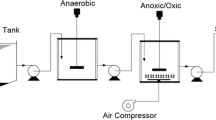Abstract
The present study aimed at investigating the biological treatment of nitrogen and phosphorus from the saline wastewater in various systems. In the end, moving bed biofilm reactor and anaerobic/anoxic/aerobic (AOA) were chosen as the best systems. In the present study, the investigations were carried out in two 24-h and 12-h retention times for three nitrogen concentrations, 200 mg/l, 300 mg/l, and 400 mg/l, two phosphorus concentrations, 14 mg/l and 20 mg/l, three Chemical oxygen demand (COD) concentrations, 800 mg/l, 1000 mg/l, and 1200 mg/l, and four salt concentrations, 10 g/l, 12 g/l, 17 g/l, and 20 g/l. The obtained results indicated that the COD removal percentage was high in a range between 91.3 and 99.1% and that this amount was decreased with increasing the amount of COD inputted to the system and the retention time was reduced with increasing the salt concentration. However, the concentration changes of the inputted ammonia were found having a lesser effect on ammonia elimination. Moreover, the increase in nitrification speed brought about an increase in the amount of nitrate entering the anoxic reactor. The nitrate removal in anoxic reactor ranged between 47.3 and 74.8%. The phosphorus removal percentage was ranging from 84.1 to 98.6%, and these changes, as well, were also decreased with the reduction in retention time and increase in the salt concentration. Microphotographic investigations were conducted on the reactors, and the microorganism existent in the aerobic reactor was identified to be the microbial species of staphylococcus warneri ATCC 27,863 (T) type.





























Similar content being viewed by others
Notes
A refinery in the south of Fars Province, Iran.
References
Chao C (2019) Simultaneous removal of COD, nitrogen and phosphorus and the tridimensional microbial response in a sequencing batch biofilm reactor: with varying C/N/P ratios. Biochem Eng J. https://doi.org/10.1016/j.bej.2019.04.017
Dincer AR, Kargi F (2001) Performance of rotating biological disk system treating saline wastewater. Process Biochem 36:901–906. https://doi.org/10.1016/S0032-9592(00)00287-9
Gebauer R (2004) Mesophilic anaerobic treatment of sludge from saline fish farm effluents with biogas production. Bioresour Technol 93(2):155–167. https://doi.org/10.1016/j.biortech.2003.10.024
Kapagiannidis AG, Zafiriadis I, Aivasidis A (2011) Upgrading the efficiency of an external nitrification BNR system—The modified Dephanox process. Chem Eng J. https://doi.org/10.1016/j.cej.2011.09.080
Karthik M, Dafale N, Pathe P, Nandy T (2008) Biodegradability enhancement of purified terephthalic acid wastewater by coagulation-flocculation process as pretreatment. J Hazard Mater 154:721–730. https://doi.org/10.1016/j.jhazmat.2007.10.085
Khannous L, Souissi N, Ghorbel B, Jarboui R, Nasri M, Gharsallah N, Kallel M (2003) Treatment of saline wastewater from marine- products processing factories by activated sludge reactor. Environ Technol 24(10):1261–1268. https://doi.org/10.1080/09593330309385668
Kima D, Kimb K-Y, Ryub H-D, Minc K-K, Lee S-I (2009) Long term operation of pilot-scale biological nutrient removal process in treating municipal wastewater. Biores Technol. https://doi.org/10.1016/j.biortech.2009.01.062
Lefbvre O, Vasudevan N, Torrijos M, Thanasekaran K, Moletta R (2004) Treatment of hypersaline industrial wastewater by a microbial consortium in a sequencing batch reactor. Environ Technol 25(5):543–553. https://doi.org/10.1080/09593330.2004.9619345
Lefbvre O, Vasudevan N, Torrijos M, Thanasekaran K, Moletta R (2005) Halophilic biological treatment of tannery soak liquor in a sequencing batch reactor. Water Res. 39(8):1471–1480. https://doi.org/10.1016/j.watres.2004.12.038
Lefebvre O, Vasudvan N, Torrijosm M, Thanasekaran K, Moletta R (2006) Anaerobic digestion of tannery soak liquor with an aerobic post-treatment. Water Res 40(7):1492–1500. https://doi.org/10.1016/j.watres.2006.02.004
Liua H, Sunb L, Xia S (2008) An efficient DPB utilization process: the modified A2N process. Biochem Eng J. https://doi.org/10.1016/j.bej.2007.06.016
Masuduz Z, Mingu K (2019) Enhanced biological phosphorus removal using thermal alkaline hydrolyzed municipal wastewater biosolids. J Environ Sci 86:164–174. https://doi.org/10.1016/j.jes.2019.05.025
Standard Methods for the Examination of water and wastewater, part 4000, Inorganic nonmetallic constituents
Mosquera-Corral A, Sanchez M, Campos JL, Mendez R, Lema JM (2001) Simultaneous methanogenesis and denitrification of pretreatment effluents from a fish canning industry. Water Res 35(2):411–418. https://doi.org/10.1016/s0043-1354(00)00288-8
Panswad T, Anan C (1999) Impact of high chloride wastewater on an anaerobic/anoxic/ aerobic process with and without inoculation of chloride acclimated seeds. Water Res 33:1165–1172. https://doi.org/10.1016/S0043-1354(98)00314-5
Puiga S, van Loosdrechta MCM, Colprimb J, Meijera SCF (2008) Data evaluation of full-scale wastewater treatment plants by mass balance. Water Res. https://doi.org/10.1016/j.watres.2008.08.009
Rovirosa N, Sanchez E, Cruz M, Borja R (2004) Coliform concentration reduction and related performance evaluation of a down-flow anaerobic fixed bed reactor treatment low- strength saline wastewater. Bioresource Tech 94:119–127. https://doi.org/10.1016/j.biortech.2003.12.010
Ucisik A, Henze SM (2004) Biological denitrification of fertilizer wastewater at high chloride concentration. Water SA 30:191–195. https://doi.org/10.4314/wsa.v30i2.5063
Uyger A, Kargi F (2004) Salt inhibition on biological nutrient removal from saline wastewater in a sequencing batch reactor. Enzyme Microb Technol 34:313–318. https://doi.org/10.1016/j.enzmictec.2003.11.010
Vermande SM, Sötemann S, Aguilera Soriano G, Wentzel M, Audic JM, Ekama G (2002) Comparison of aerobic and anoxic phosphorus uptake in NDBEPR systems (UCT and ENBNRAS). Water Sci Technol 46:201–207
Viessman W, Hammer MJ, Percz EM (2009) Water supply and pollution control. Pearson Prentice hall, Englewood Cliffs
Yi K, Wang D (2017) Nickel toxicity to the performance and microbial community of enhanced biological phosphorus removal system. Chem Eng J. https://doi.org/10.1016/j.cej.2016.12.078
Zeng W, Li L, Yang Y-Y, Wang X-D, Peng Y-Z (2011) Denitrifying phosphorus removal and impact of nitrite accumulation on phosphorus removal in a continuous anaerobic–anoxic–aerobic (AOA) process treating domestic wastewater. Enzyme Microb Technol. https://doi.org/10.1016/j.enzmictec.2010.10.010
Zhu Y, Tu X (2018) Biological activities and nitrogen and phosphorus removal during the anabaena flos-aquae biofilm growth using different nutrient form. Bioresour Technol. https://doi.org/10.1016/j.biortech.2017.12.003
Zubrowska-Sudol M, Walczak J (2015) Enhancing combined biological nitrogen and phosphorus removal from wastewater by applying mechanically disintegrated excess sludge. Water Res. https://doi.org/10.1016/j.watres.2015.02.041
Acknowledgement
This study has two grant of financial support, thank you from the Parsian Gas Refinery for financial support and from Sharif University of Technology for the availability of laboratories
Author information
Authors and Affiliations
Corresponding author
Ethics declarations
Conflict of interest
The authors declare that they have no conflict of interest.
Additional information
Editorial responsibility: M. Abbaspour.
Rights and permissions
About this article
Cite this article
Delashoob, A., Borghei, S.M. Optimization of multistage biological nutrient removal reactors for removal of nitrogen and phosphorus from saline refinery wastewater. Int. J. Environ. Sci. Technol. 17, 4865–4878 (2020). https://doi.org/10.1007/s13762-020-02772-3
Received:
Revised:
Accepted:
Published:
Issue Date:
DOI: https://doi.org/10.1007/s13762-020-02772-3




